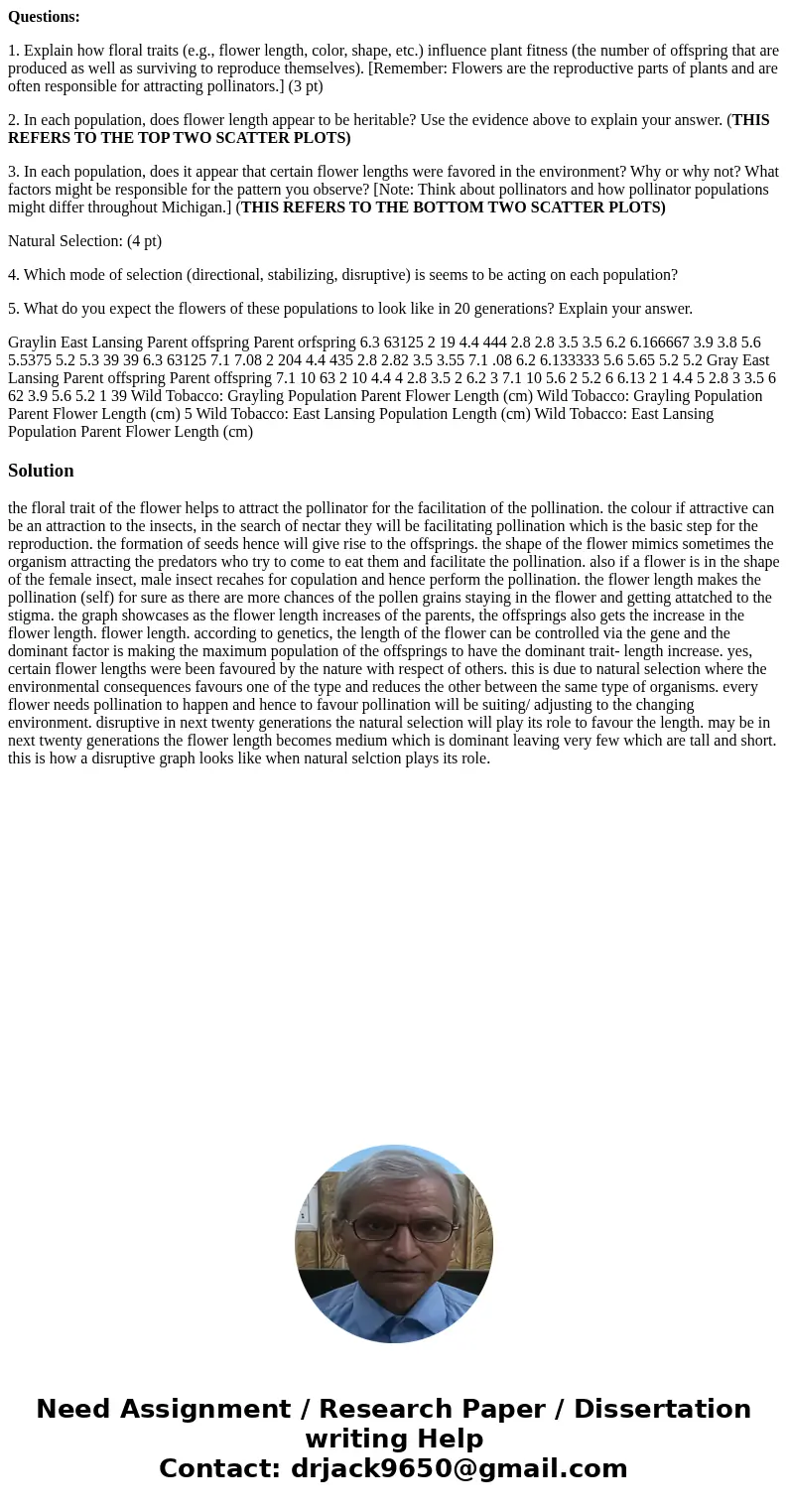Questions 1 Explain how floral traits eg flower length color
Questions:
1. Explain how floral traits (e.g., flower length, color, shape, etc.) influence plant fitness (the number of offspring that are produced as well as surviving to reproduce themselves). [Remember: Flowers are the reproductive parts of plants and are often responsible for attracting pollinators.] (3 pt)
2. In each population, does flower length appear to be heritable? Use the evidence above to explain your answer. (THIS REFERS TO THE TOP TWO SCATTER PLOTS)
3. In each population, does it appear that certain flower lengths were favored in the environment? Why or why not? What factors might be responsible for the pattern you observe? [Note: Think about pollinators and how pollinator populations might differ throughout Michigan.] (THIS REFERS TO THE BOTTOM TWO SCATTER PLOTS)
Natural Selection: (4 pt)
4. Which mode of selection (directional, stabilizing, disruptive) is seems to be acting on each population?
5. What do you expect the flowers of these populations to look like in 20 generations? Explain your answer.
Graylin East Lansing Parent offspring Parent orfspring 6.3 63125 2 19 4.4 444 2.8 2.8 3.5 3.5 6.2 6.166667 3.9 3.8 5.6 5.5375 5.2 5.3 39 39 6.3 63125 7.1 7.08 2 204 4.4 435 2.8 2.82 3.5 3.55 7.1 .08 6.2 6.133333 5.6 5.65 5.2 5.2 Gray East Lansing Parent offspring Parent offspring 7.1 10 63 2 10 4.4 4 2.8 3.5 2 6.2 3 7.1 10 5.6 2 5.2 6 6.13 2 1 4.4 5 2.8 3 3.5 6 62 3.9 5.6 5.2 1 39 Wild Tobacco: Grayling Population Parent Flower Length (cm) Wild Tobacco: Grayling Population Parent Flower Length (cm) 5 Wild Tobacco: East Lansing Population Length (cm) Wild Tobacco: East Lansing Population Parent Flower Length (cm)Solution
the floral trait of the flower helps to attract the pollinator for the facilitation of the pollination. the colour if attractive can be an attraction to the insects, in the search of nectar they will be facilitating pollination which is the basic step for the reproduction. the formation of seeds hence will give rise to the offsprings. the shape of the flower mimics sometimes the organism attracting the predators who try to come to eat them and facilitate the pollination. also if a flower is in the shape of the female insect, male insect recahes for copulation and hence perform the pollination. the flower length makes the pollination (self) for sure as there are more chances of the pollen grains staying in the flower and getting attatched to the stigma. the graph showcases as the flower length increases of the parents, the offsprings also gets the increase in the flower length. flower length. according to genetics, the length of the flower can be controlled via the gene and the dominant factor is making the maximum population of the offsprings to have the dominant trait- length increase. yes, certain flower lengths were been favoured by the nature with respect of others. this is due to natural selection where the environmental consequences favours one of the type and reduces the other between the same type of organisms. every flower needs pollination to happen and hence to favour pollination will be suiting/ adjusting to the changing environment. disruptive in next twenty generations the natural selection will play its role to favour the length. may be in next twenty generations the flower length becomes medium which is dominant leaving very few which are tall and short. this is how a disruptive graph looks like when natural selction plays its role.
 Homework Sourse
Homework Sourse